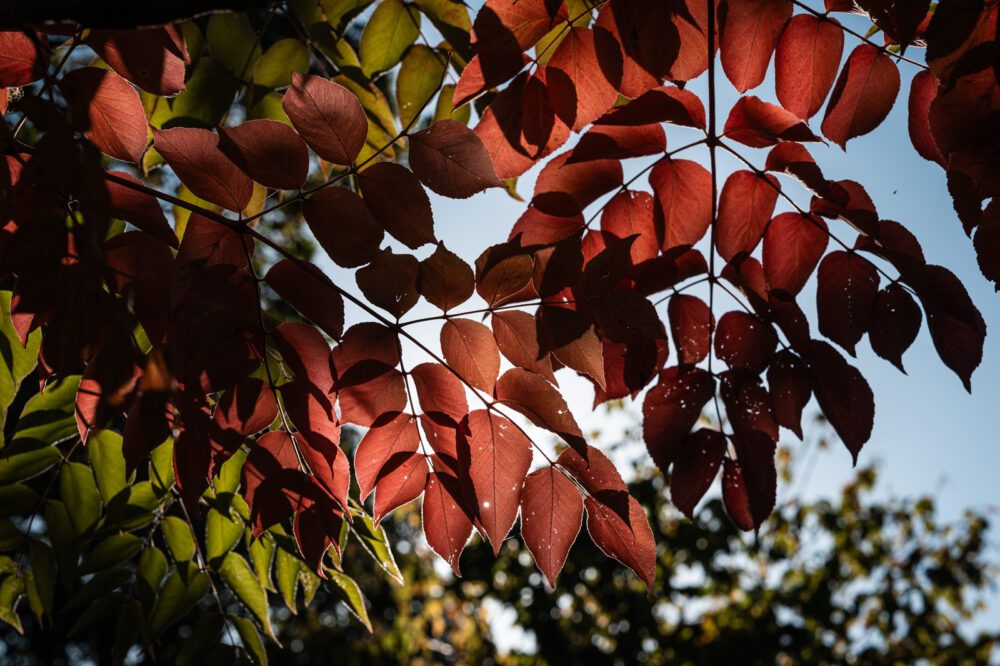‘The Slow Turn’ by Andrew Jackson


Our September blog post by resident writer, Andrew Jackson, invites you to immerse yourself in the garden’s cyclical transformation. Bask in the soft early autumn light, breathe in the fragrant dew on windfallen fruit, and let the gentle birdsong surround you, accompanied by the occasional snap of a seedhead in the warm afternoon sun.
Over to Andrew…
The Slow Turn
The garden, tucked beneath the keep of the ruined castle, holds its own weather, its own hours. Step through the gate in late September and the world outside seems to falter, as if the boundary itself marks a pause in time. The air is softer, dulled with a smoky light that leans across the brickwork. The season is changing, not abruptly, but in a slow exhalation. Summer’s brightness has not vanished, but it has begun to slacken, to loosen its grip.
This is the hinge of the year. The garden is no longer driven by the urgent upward force of spring or the hot luxuriance of July. Instead, it is in a kind of reflective state, where growth and decline exist side by side. One path offers a flush of late flowers still performing for bees in the warmth of the sun, another is edged with seed-heads already tipped to bronze, rattling like faint percussion in the breeze. It is impossible to say whether the garden is beginning or ending. Both are true.

The walled enclosure amplifies this sense of paradox. The brick walls, heat-soaked through long months of sunlight, hold on to warmth even as nights sharpen. They shelter the last tender growths from early frosts. They trap the scents of earth and fallen leaves, intensifying them into something almost edible. The walls themselves become participants in the season, not just backdrops but slow-breathing companions.
Walking here in September is to sense time in layers. Above, in the clearings between branches, the sky seems washed and distant, its blue touched with silver. On the ground, the soil has taken on a darker hue, the moist richness of rain after heat. Between these layers, in the middle register, plants shift in tone. The green of summer has thickened, become heavier, more substantial. Even leaves yet untouched by autumn flame feel weighted, as though they have drawn in all the light they can bear, and are ready now to release it.
Everywhere is this mingling of fullness and retreat. The air is alive with small motions—the dipping flight of a bird testing the air before migration, the low murmur of bees intent on their final circuits, the drift of seeds uncoupling themselves and surrendering to chance. These are not movements of urgency but of acceptance. There is no rush. The rhythm is slower, deliberate, like a garden exhaling at the end of a long recital.

The walls frame these scenes with a painter’s precision. Look one way and you see a corridor of golds and russets catching the sun; turn another and shadows pool beneath canopies, the first hints of winter’s starkness rehearsed in miniature. The garden becomes a kaleidoscope of transience, a study in impermanence.
And yet, in this very impermanence lies its power. For a visitor, the sense of being held inside this turning of the year is strangely consoling. The garden is not dying but transforming, each falling petal or collapsing stem a necessary stage in the cycle. Decay here is not loss but a passage into renewal. The seed-head is as beautiful as the flower, perhaps more so, because it contains within its fragile case the promise of another year.

There is also a shift in sound. Where in summer the garden brims with chatter—the overlapping calls of swifts, the hum of insects—September’s music is subtler, lower-pitched. Wind strokes the walls with a hollow tone. The footfall on damp paths has a muffled quality. Even the birds, fewer now, seem to speak more softly, as if aware of the need for economy. The whole place is a study in restraint.
The castle ruins above provide a counterpoint to this seasonal narrative. Their permanence, their centuries of weathering, make the garden’s quickening and fading feel more poignant. The walls of the fortress have seen thousands of such Septembers; they stand unmoved while everything within the garden shifts and alters. Yet even the stones carry their own version of change—lichens thickening, cracks widening, ivy slowly advancing. The garden and the ruin, together, remind us that change is the only constant, whether played out over days or centuries.

By late afternoon, the light changes again. It softens, slants lower, pouring across the surfaces of fruit and leaf so that each detail is illuminated. The textures of the season are revealed: rough bark, crumpled petal, downy seed. It is a light that does not flatter but reveals, lingering over imperfection and finding in it a kind of beauty. In the garden’s edges and overlooked corners, one notices the delicacy of cobwebs beaded with damp, the geometry of drying seed-pods, the quiet occupation of fungi breaking down what has been left.
Even the soil has a different presence now. It exhales a rich, humic scent, the smell of things turning back into themselves. Dig your hand into it and you feel warmth below the cool surface, the stored energy of summer slowly diffusing. There is comfort in this: the knowledge that beneath apparent decline lies a bed of renewal, patient and invisible.

This is perhaps why September in the walled garden feels so moving. It makes visible the whole arc of time, not just its celebratory moments. The glamour of bloom has its place, but here, at summer’s end, the garden teaches us that fading is also a form of flourishing. The structures revealed in decline are often more intricate, more revealing of character, than the lushness that concealed them.
It is no coincidence that visitors at this time of year often walk more slowly. They linger by walls, pause to trace the outlines of seed heads, stoop to watch an insect burrow into a fading flower. The garden invites a different kind of attention—less about abundance, more about nuance. It requires us to attune ourselves to subtler registers: the faint shift of colour in a leaf margin, the hushed click of a seed-case, the way light catches on brick at dusk.
The garden in September is not a spectacle but a meditation. Its lessons are not about conquest or display but about accommodation, patience, and the quiet resilience of cycles. Within its walls, one feels held by an older rhythm, one that tempers the human urge for linear progress. Here, endings fold seamlessly into beginnings, and decline is not defeat but preparation.

As the day draws down, shadows lengthen across the beds. The air cools, the walls release the last of their stored warmth. A hush settles, as if the garden is gathering itself into silence. It is not emptiness but fullness of another kind—a fullness of rest, of laying down, of trust in the unseen work of the earth.
Standing at the threshold again, ready to step back into the outer world, you carry with you the garden’s quiet insistence: that change need not be feared, that beauty resides as much in letting go as in holding on, and that within walls of brick and stone, as within the walls of our own lives, the turning of the year is both an ending and a beginning.
The garden at the end of September does not shout its presence. It whispers, it leans into subtlety, it shows us the dignity of passing time. To walk here is to glimpse the deep pulse of the seasons, to feel, for a moment, the measured breath of the earth itself.
Andrew Jackson
Andrew is a new build gardener and the visionary founder of the New Build Manifesto, a campaign championing better access to and higher quality new build spaces. As an award-winning garden designer and writer who was featured on BBC Gardeners’ World in June, 2025, Andrew embodies the creativity and passion that comes from time spent outdoors, in nature .
Follow Andrew’s journey via the links below:
Scribehound Gardening
@thenewbuildmanifesto
Photo credits – Colin Dilcock, Stephen Barstow, Andrew Jackson (pictured below)
 Filed under: Blog
Filed under: Blog 


